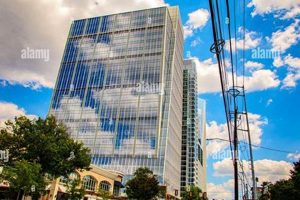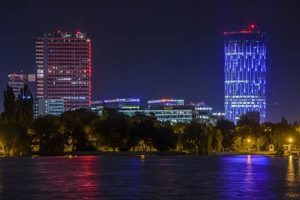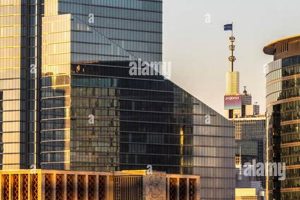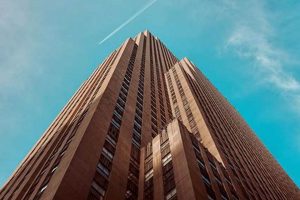Skyscrapers, defined as high-rise buildings that have over 40 floors and are taller than 150 meters, have become iconic landmarks in major cities around the world. They are marvels of engineering and architectural prowess, pushing the boundaries of design and functionality.
The construction of skyscrapers has numerous benefits. They provide valuable real estate in densely populated urban areas, accommodating a large number of people and businesses within a limited footprint. Additionally, skyscrapers serve as symbols of economic prosperity and technological advancement, attracting tourism and investment. Historically, the race to build the tallest skyscraper has been a driving force behind architectural innovation and the development of new construction techniques.
In this article, we will explore some of the most famous skyscrapers in the world, examining their unique designs, engineering feats, and cultural significance. We will delve into the history of these architectural wonders and discuss their impact on the skylines of major cities.
1. Height
Height, a defining characteristic of famous skyscrapers, plays a crucial role in their design, engineering, and cultural significance.
- Vertical Dominance: Skyscrapers strive to reach new heights, symbolizing power, ambition, and technological prowess. The Burj Khalifa, standing at 828 meters, exemplifies this quest for vertical dominance, dominating the Dubai skyline.
- Engineering Feats: Building tall requires innovative engineering solutions to overcome challenges posed by wind, gravity, and seismic activity. The Shanghai Tower’s double-skin facade, for instance, enhances structural stability and reduces wind resistance.
- Functional Considerations: Height influences the building’s functionality. Supertall skyscrapers often incorporate mixed-use programs, accommodating offices, residential units, and retail spaces within a single structure, maximizing space utilization.
- Urban Icons: Famous skyscrapers become iconic landmarks, defining city skylines and serving as orientation points. The Empire State Building, with its Art Deco design and towering presence, has become an enduring symbol of New York City.
In conclusion, height is not merely a physical attribute but a defining element that shapes the design, engineering, and cultural impact of famous skyscrapers. It represents architectural ambition, engineering ingenuity, functional adaptability, and urban identity.
2. Design
Design, an integral aspect of famous skyscrapers, encompasses both aesthetics and functionality, shaping their visual appeal and performance. It involves the skillful integration of architectural elements, engineering considerations, and cultural influences.
Skyscrapers, as vertical cities within themselves, present unique design challenges. Architects must carefully consider factors such as wind resistance, structural stability, and efficient space utilization. Innovative design solutions, such as the use of buttresses and setbacks, enhance structural integrity while creating visually striking forms. For instance, the Chrysler Building’s Art Deco spire not only adds aesthetic flair but also serves as a structural support.
Furthermore, the design of famous skyscrapers often reflects the cultural context and architectural trends of their time. The Empire State Building, constructed during the Art Deco era, showcases geometric patterns and stylized ornamentation that were popular in the 1930s. In contrast, the Burj Khalifa’s sleek and minimalist design embodies the modern architectural style prevalent in the 21st century.
In conclusion, design plays a pivotal role in shaping the identity and significance of famous skyscrapers. It involves a delicate balance of aesthetics, engineering, and cultural influences, resulting in architectural marvels that push the boundaries of design and functionality.
3. Engineering
Engineering is the backbone of famous skyscrapers, shaping their structural integrity, functionality, and aesthetic appeal. It involves the application of scientific and technical principles to design, construct, and maintain these architectural marvels.
Skyscrapers, by their very nature, present unique engineering challenges. They must withstand immense gravitational forces, wind loads, and seismic activity. Engineers employ innovative techniques to overcome these challenges. For instance, the use of reinforced concrete, steel frames, and advanced damping systems ensures structural stability and resilience against external forces. The Taipei 101 skyscraper in Taiwan is a testament to such engineering prowess, having withstood several earthquakes and typhoons during its existence.
Moreover, engineering plays a crucial role in optimizing space utilization and maximizing energy efficiency in skyscrapers. Advanced building materials, such as lightweight composites and high-performance glass, reduce the overall weight of the structure while enhancing its thermal insulation. Intelligent building systems, including automated lighting and HVAC controls, contribute to energy conservation and environmental sustainability.
In conclusion, engineering is not merely a technical discipline but an art form in the context of famous skyscrapers. It enables architects to transform audacious designs into tangible structures, pushing the boundaries of human ingenuity and reshaping the skylines of major cities.
4. Function
Function plays a pivotal role in shaping the design, engineering, and cultural significance of famous skyscrapers. These architectural marvels are not mere aesthetic statements but serve specific purposes that reflect the needs and aspirations of modern society.
- Vertical Cities: Skyscrapers, particularly mixed-use developments, function as vertical cities within themselves, housing a multitude of activities and amenities. They combine offices, residential units, retail spaces, and public facilities, creating vibrant and self-sustaining communities.
- Economic Hubs: Famous skyscrapers often house corporate headquarters and financial institutions, making them centers of commerce and economic activity. The concentration of businesses in these vertical structures facilitates collaboration, innovation, and economic growth.
- Tourist Destinations: Iconic skyscrapers, with their unique designs and observation decks, attract tourists from around
the globe. They offer breathtaking views, immersive experiences, and a glimpse into the architectural marvels of our time. - Cultural Landmarks: Famous skyscrapers transcend their functional purposes and become cultural landmarks, symbolizing civic pride and national identity. They embody architectural achievements, inspire artistic expression, and contribute to the cultural fabric of cities.
In conclusion, the function of famous skyscrapers extends beyond providing shelter or housing businesses. They are multifaceted structures that serve as economic hubs, tourist destinations, cultural landmarks, and vertical communities, shaping the urban landscape and contributing to the vitality and prosperity of modern cities.
5. Location
Location plays a pivotal role in the design, significance, and cultural impact of famous skyscrapers. These architectural marvels are inextricably linked to the urban fabric, shaping and being shaped by their surroundings.
- Urban Centers: Famous skyscrapers often grace the skylines of major cities, serving as focal points and symbols of economic and cultural prowess. The Empire State Building, for instance, stands as an iconic landmark in the heart of New York City, embodying the city’s vibrant energy and global influence.
- Landmark Destinations: Some skyscrapers are strategically located to become landmarks and tourist destinations. The Burj Khalifa in Dubai, situated next to the Dubai Mall and other attractions, attracts visitors from around the world, contributing to the city’s tourism industry and global recognition.
- Transportation Hubs: Famous skyscrapers can be integrated with transportation hubs, providing convenient access and connectivity. The Taipei 101 skyscraper in Taiwan, for example, is directly connected to a metro station and a major bus terminal, enhancing its accessibility and convenience for tenants and visitors.
- Cultural Significance: The location of a famous skyscraper can also hold cultural significance. The Petronas Towers in Kuala Lumpur, Malaysia, are designed to resemble motifs found in Islamic art and architecture, reflecting the country’s cultural heritage and identity.
In conclusion, location is not merely an address but an integral aspect of famous skyscrapers, influencing their design, functionality, cultural meaning, and overall impact on the urban environment.
6. Symbolism
Famous skyscrapers, reaching towards the sky, often embody powerful symbolic meanings, transcending their physical presence to become cultural icons and emblems of national identity, economic strength, and architectural prowess.
Skyscrapers, with their towering heights and impressive scale, can represent a nation’s ambition, technological advancements, and economic prosperity. For example, the Burj Khalifa in Dubai, standing as the tallest building in the world, symbolizes the United Arab Emirates’ rapid economic growth and global aspirations. Similarly, the Petronas Towers in Kuala Lumpur, Malaysia, reflect the country’s Islamic heritage and cultural identity through their unique design inspired by traditional Islamic motifs.
Beyond national symbolism, famous skyscrapers can also carry cultural and historical significance. The Empire State Building in New York City, a towering Art Deco masterpiece, evokes the glamour and optimism of the 1930s and has become an enduring symbol of the city itself. The Eiffel Tower in Paris, initially constructed for the 1889 World’s Fair, has become an iconic landmark representing France’s rich history and engineering prowess.
The symbolic value of famous skyscrapers extends beyond their physical form, influencing urban planning, tourism, and national pride. These architectural marvels attract visitors from around the globe, contributing to local economies and promoting cultural exchange. They serve as backdrops for major events, celebrations, and media coverage, further solidifying their symbolic importance.
Understanding the symbolism associated with famous skyscrapers provides valuable insights into the cultural, historical, and economic factors that shape urban landscapes. It highlights the interplay between architecture, society, and national identity, demonstrating how buildings can transcend their functional purposes to become potent symbols that resonate with people on a deeper level.
7. Innovation
Innovation is an intrinsic component of famous skyscrapers, driving advancements in design, engineering, and construction techniques. It encompasses the creation of novel solutions to overcome challenges posed by height, structural stability, and functional requirements.
Skyscrapers, with their soaring heights and complex designs, demand innovative approaches to ensure structural integrity and efficient space utilization. Engineers employ advanced materials, such as high-strength concrete and lightweight composites, to reduce weight and enhance resilience against wind and seismic forces. The Burj Khalifa, for instance, utilizes a buttressed core structural system to withstand lateral loads and achieve its record-breaking height.
Innovation extends beyond structural considerations to encompass sustainable design and energy efficiency. Famous skyscrapers incorporate green building technologies, such as solar panels, rainwater harvesting systems, and automated lighting controls, to reduce environmental impact and promote sustainability. The Taipei 101 skyscraper, renowned for its eco-friendly features, has achieved LEED Platinum certification, demonstrating its commitment to environmental stewardship.
Furthermore, innovation plays a crucial role in enhancing the functionality and user experience of famous skyscrapers. Advanced elevators and transportation systems facilitate efficient vertical movement, while intelligent building management systems optimize energy consumption and provide personalized comfort settings. The Shanghai Tower, for example, boasts the world’s fastest elevators, traveling at speeds of up to 20 meters per second.
Understanding the connection between innovation and famous skyscrapers is essential for continued advancements in high-rise construction. It enables architects and engineers to push the boundaries of design and engineering, creating iconic structures that redefine skylines and enhance urban living.
8. Sustainability
Sustainability has emerged as a critical aspect of famous skyscrapers, driven by increasing environmental awareness and the need for responsible urban development. Famous skyscrapers, with their massive scale and energy consumption, have a significant impact on the environment. As a result, architects and engineers are incorporating innovative sustainable design strategies to reduce the environmental footprint of these iconic structures.
One key aspect of sustainability in famous skyscrapers is energy efficiency. Advanced building management systems optimize energy consumption b
y monitoring and controlling lighting, heating, and cooling systems. The Burj Khalifa, for instance, utilizes a double-skin facade that reduces heat gain and lowers energy demand. Additionally, many famous skyscrapers incorporate renewable energy sources, such as solar panels and wind turbines, to generate clean energy and reduce reliance on fossil fuels.
Another important aspect of sustainability is water conservation. Famous skyscrapers employ rainwater harvesting systems to collect and store rainwater for non-potable uses, such as irrigation and flushing toilets. The Taipei 101 skyscraper has implemented a rainwater collection system that meets approximately 20% of its water demand. Furthermore, water-efficient fixtures and appliances are installed to minimize water consumption.
Understanding the connection between sustainability and famous skyscrapers is crucial for promoting environmentally responsible urban development. By embracing sustainable practices, famous skyscrapers can set an example for other buildings and contribute to a greener, more sustainable future.
9. Cultural impact
Famous skyscrapers, reaching towards the sky, have a profound cultural impact, shaping the identity of cities, influencing popular culture, and inspiring artistic expression. They transcend their functional purposes to become symbols of human ambition, technological prowess, and cultural aspirations.
- Identity and Symbolism: Famous skyscrapers become iconic landmarks, deeply intertwined with the identity of the cities they inhabit. The Empire State Building, for instance, is an enduring symbol of New York City, while the Petronas Towers are synonymous with Kuala Lumpur. These structures embody the spirit and aspirations of their respective cities, serving as sources of pride and cultural attachment.
- Tourism and Recreation: Famous skyscrapers attract visitors from around the globe, becoming major tourist destinations. Observation decks, such as those found in the Burj Khalifa and the Shanghai Tower, offer breathtaking panoramic views, attracting tourists eager to experience the and architectural marvels of these iconic structures.
- Art and Inspiration: Famous skyscrapers have served as muses for artists, writers, and filmmakers. Their unique forms and towering presence have inspired countless works of art, literature, and cinema. The Chrysler Building, with its Art Deco design, has been featured in numerous films and television shows, while the Taipei 101 skyscraper has been immortalized in paintings and photographs.
- Community and Gatherings: Famous skyscrapers often incorporate public spaces, plazas, and gardens, creating vibrant gathering places for communities. These spaces host events, concerts, and cultural activities, fostering a sense of community and belonging among residents and visitors alike.
In conclusion, the cultural impact of famous skyscrapers is multifaceted, encompassing their role as symbols of identity, tourist destinations, sources of artistic inspiration, and community gathering places. These architectural marvels transcend their physical presence to become woven into the fabric of urban life, shaping cultural narratives and inspiring generations.
FAQs about Famous Skyscrapers
Skyscrapers, reaching towards the heavens, have become iconic symbols of human ingenuity and architectural prowess. Yet, these majestic structures often raise questions and misconceptions. This FAQ section aims to provide clear and informative answers to some of the most common inquiries surrounding famous skyscrapers.
Question 1: What defines a skyscraper?
A skyscraper is generally defined as a high-rise building that has over 40 floors and stands taller than 150 meters (492 feet). However, there is no universally accepted definition, and the threshold may vary depending on the context and region.
Question 2: Which is the tallest skyscraper in the world?
As of 2023, the Burj Khalifa in Dubai, United Arab Emirates, holds the title of the world’s tallest skyscraper. It stands at an impressive height of 828 meters (2,717 feet) and has 163 floors.
Question 3: Are skyscrapers safe in high winds and earthquakes?
Skyscrapers are designed to withstand strong winds and earthquakes through a combination of structural engineering techniques and advanced materials. They often employ reinforced concrete, steel frames, and innovative damping systems to ensure stability and resilience.
Question 4: How do people get to the upper floors of skyscrapers?
Skyscrapers are equipped with high-speed elevators that can travel at remarkable speeds. Some of the tallest skyscrapers may have multiple elevator banks and express elevators that serve specific floors to optimize efficiency.
Question 5: Do skyscrapers have special fire safety measures?
Yes, skyscrapers have stringent fire safety protocols and systems in place. These include fire sprinklers, smoke detectors, fire alarms, and designated fire escape routes. Some skyscrapers also employ advanced fire suppression systems, such as water mist or inert gas systems.
Question 6: How do skyscrapers contribute to the urban environment?
Skyscrapers can contribute to urban environments in various ways. They provide valuable office and residential space, reducing urban sprawl and promoting vertical growth. Additionally, skyscrapers can incorporate green building features, enhance public transportation connectivity, and serve as cultural landmarks.
In conclusion, famous skyscrapers represent architectural marvels that push the boundaries of design and engineering. Understanding the answers to these frequently asked questions sheds light on their impressive features, safety measures, and contributions to the urban landscape.
Transitioning to the next section, we will delve deeper into the fascinating world of famous skyscrapers, exploring their architectural styles, historical significance, and cultural impact.
Tips for Appreciating Famous Skyscrapers
To fully experience the grandeur and significance of famous skyscrapers, consider the following tips:
Tip 1: Research the history and context:
Before visiting a famous skyscraper, take some time to learn about its history, architectural style, and the surrounding urban context. This will enhance your understanding and appreciation of the building’s design and significance.Tip 2: Visit the observation deck:
Most famous skyscrapers offer observation decks that provide breathtaking panoramic views of the city. Take advantage of these opportunities to experience the cityscape from a unique perspective and gain a deeper understanding of the building’s scale and surroundings.Tip 3: Explore the surrounding area:
Skyscrapers often serve as focal points within their urban environments. Explore the surrounding streets and neighborhoods to appreciate how the building interacts with its context and contributes to the overall character of the city.Tip 4: Pay attention to architectural details:
Famous skyscrapers are renowned for their intricate designs and innovative construction techniques. Take time to observe the building’s facade, structural elements, and ornamentation to appreciate the skill and creativity of the architects and engineers involved.Tip 5: Consider the building’s symbolism and cultural impact:
Skyscrapers often transcend their functional purposes an
d become symbols of national pride, economic prosperity, or cultural identity. Reflect on the broader meanings and associations associated with the building to gain a deeper understanding of its cultural significance.Tip 6: Visit at different times of the day:
The appearance of skyscrapers can vary dramatically depending on the time of day and lighting conditions. Plan visits at different times to experience the building’s changing moods and how it interacts with natural light.Summary:
By following these tips, you can enrich your appreciation of famous skyscrapers, gaining a deeper understanding of their architectural significance, cultural impact, and the ways in which they shape the urban landscape.
As you embark on your exploration of these architectural wonders, remember to embrace a curious and open mind. Skyscrapers offer a unique window into the human quest for verticality, innovation, and the creation of iconic landmarks that define our cities and inspire generations.
Conclusion
As we conclude our exploration of famous skyscrapers, it is evident that these architectural marvels are more than just towering structures; they are testaments to human ingenuity, engineering prowess, and cultural aspirations. Throughout history, skyscrapers have pushed the boundaries of design and technology, reshaping skylines and transforming urban landscapes.
From the Art Deco elegance of the Empire State Building to the futuristic grandeur of the Burj Khalifa, each famous skyscraper stands as a unique expression of its time and place. They serve as symbols of economic prosperity, national pride, and the relentless pursuit of verticality. Moreover, skyscrapers have a profound impact on the urban environment, providing valuable space, enhancing transportation connectivity, and creating vibrant public spaces.
As we look towards the future, it is exciting to imagine the new heights and innovative designs that will continue to grace the world’s skylines. Famous skyscrapers will undoubtedly remain at the forefront of architectural advancements, pushing the limits of what is possible and inspiring generations to come.







